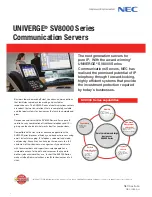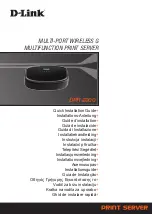
Use
the
IBM
ServeRAID
Configuration
Utility
program,
Adaptec
RAID
Configuration
Utility
program,
and
ServeRAID
Manager
to
configure
and
manage
redundant
array
of
independent
disks
(RAID).
Be
sure
to
use
these
programs
as
described
in
this
document.
The
ServeRAID
8k-l
SAS
Controller
that
comes
with
the
server
(hot-swap
SAS
and
hot-swap
SATA
models)
enables
you
to
configure
multiple
physical
SAS
or
SATA
hard
disk
drives
to
operate
as
logical
drives
in
a
disk
array.
The
server
comes
with
a
CD
containing
the
ServeRAID
Manager
program,
which
you
can
use
to
configure
the
ServeRAID
8k-l
SAS
Controller.
If
your
server
comes
with
an
operating
system
installed,
such
as
Microsoft
Windows
2000
Datacenter
Server,
see
the
software
documentation
that
comes
with
the
server
for
configuration
information.
Use
these
programs
to
perform
the
following
tasks:
v
Perform
a
low-level
format
on
a
hard
disk
drive
v
View
or
change
IDs
for
attached
devices
v
Set
protocol
parameters
on
hard
disk
drives
v
Monitor
operation
of
the
RAID
controller
v
Configure
a
redundant
array
of
independent
disks
(RAID)
array
v
View
or
change
the
RAID
configuration
and
associated
devices
Consider
the
following
information
when
using
the
RAID
configuration
programs
to
configure
and
manage
arrays:
v
The
integrated
SATA
controller
(simple-swap
SATA
models)
with
integrated
SATA
RAID
(also
known
as
HostRAID)
supports
RAID
level-0
and
level-1
when
two
drives
are
installed.
When
the
maximum
four
drives
are
installed,
RAID
level-10
is
also
supported.
Note:
In
addition,
when
the
maximum
four
drives
and
the
optional
ServeRAID-8k
Controller
are
installed
in
the
simple-swap
SATA
models,
the
server
can
also
support
RAID
level-5.
See
for
details
about
installing
and
cabling
the
ServeRAID-8k
Controller
to
enable
RAID
level-5
support
on
simple-swap
SATA
models.
v
The
onboard
SAS/SATA
controller
(hot-swap
SAS
and
hot-swap
SATA
models)
supports
RAID
level-0
and
level-1
when
two
drives
and
the
ServeRAID
8k-l
controller
are
installed.
When
four
drives
are
installed,
RAID
level-10
is
also
supported.
When
you
upgrade
to
the
maximum
eight
drives
and
the
optional
ServeRAID-8k
controller
is
installed,
RAID
levels
1e,
5,
and
6
also
are
supported.
v
Hard
disk
drive
capacities
affect
how
you
create
arrays.
The
drives
in
an
array
can
have
different
capacities,
but
the
RAID
controller
treats
them
as
if
they
all
have
the
capacity
of
the
smallest
hard
disk
drive.
v
To
help
ensure
signal
quality,
do
not
mix
drives
with
different
speeds
and
data
rates.
v
To
update
the
firmware
and
BIOS
code
for
an
optional
ServeRAID
controller,
you
must
use
the
IBM
ServeRAID
Support
CD
that
comes
with
the
ServeRAID
option.
v
If
you
install
a
different
type
of
RAID
controller
in
the
server,
use
the
method
that
is
described
in
the
instructions
that
come
with
the
controller
to
view
or
change
settings
for
attached
devices.
Chapter
5.
Configuration
information
and
instructions
167
Summary of Contents for System x3400 Type 7973
Page 1: ...System x3400 Types 7973 7974 7975 and 7976 Problem Determination and Service Guide...
Page 2: ......
Page 3: ...System x3400 Types 7973 7974 7975 and 7976 Problem Determination and Service Guide...
Page 8: ...vi System x3400 Types 7973 7974 7975 and 7976 Problem Determination and Service Guide...
Page 18: ...xvi System x3400 Types 7973 7974 7975 and 7976 Problem Determination and Service Guide...
Page 34: ...16 System x3400 Types 7973 7974 7975 and 7976 Problem Determination and Service Guide...
Page 104: ...86 System x3400 Types 7973 7974 7975 and 7976 Problem Determination and Service Guide...
Page 112: ...94 System x3400 Types 7973 7974 7975 and 7976 Problem Determination and Service Guide...
Page 182: ...164 System x3400 Types 7973 7974 7975 and 7976 Problem Determination and Service Guide...
Page 192: ...174 System x3400 Types 7973 7974 7975 and 7976 Problem Determination and Service Guide...
Page 200: ...182 System x3400 Types 7973 7974 7975 and 7976 Problem Determination and Service Guide...
Page 209: ......
Page 210: ...Part Number 31R2197 Printed in USA 1P P N 31R2197...
















































